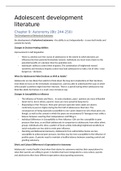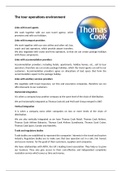Adolescent development
literature
Chapter 9: Autonomy (Blz 244-250)
The Development of Behavioral Autonomy
the development of behavioral autonomy—the ability to act independently—is seen both inside and
outside the family
Changes in Decision-Making Abilities
Improvements in Self-Regulation
- There is a decline over the course of adolescence in the extent to which decisions are
influenced by their potential immediate rewards. Individuals are much more drawn to the
potential benefits of a decision than the potential costs.
- Individuals’ ability to control their impulses. The combination of heightened reward
sensitivity and immature impulse control may lead adolescents to make a lot of risky—even
dangerous—decisions.
When Do Adolescents Make Decisions as Well as Adults?
Adolescents are less likely than adults to think about the long-term implications of their decisions,
more likely to focus on the immediate consequences, and less able to understand the ways in which
other people’s positions might bias their interests. There is a period during which adolescents may
think like adults but behave in a much more immature way
Changes in Susceptibility to Influence
- The Influence of Parents and Peers: . In some situations, peers’ opinions are more influential
(short-term), but in others, parents’ views are more powerful (long-term).
- Responding to Peer Pressure: Most peer pressure operates when adults are absent.
conformity to peers is higher during the first half of adolescence than later. The
consequences of being especially susceptible to one’s peers depend on who those peers are,
though, as well as the context in which the peers are encountered à Teenagers must strike a
balance between asserting their independence and fitting in
- Individual Differences in Susceptibility to Peer Influence: Girls are less susceptible to peer
pressure than boys, as are Black adolescents in comparison to adolescents from other ethnic
groups. Individuals who show a pattern of brain activity indicating heightened sensitivity to
social evaluation are less able to resist peer influence.
- Parenting and Behavioral Autonomy: Adolescents from authoritative homes are less
susceptible to antisocial peer pressure, but they may be more susceptible to the influence of
positive peers. à parents need to maintain a healthy balance between asserting control and
granting autonomy.
Ethnic and Cultural Differences in Expectations for Autonomy
Adolescents’ mental health is best when their desire for autonomy matches their expectations for
what their parents are willing to grant. In families that have immigrated to a new culture, parents
and adolescents often have different expectations about granting autonomy.
,Chapter 9 Autonomy (pages 236-244, 250-261)
autonomy is not just about acting independently; it is also about feeling independent and thinking
for oneself. Many young people who are emotionally independent from their parents find it
frustrating to have to abide by their rules as long as their parents are supporting them economically.
The paradox of adolescent autonomy is that whereas adolescents today are expected to be
increasingly autonomous psychologically and socially, they are now less autonomous economically.
Autonomy as an Adolescent Issue
Puberty and the Development of Autonomy
Adolescents’ interest in turning away from parents and toward peers for emotional support—part of
establishing adult independence—may be stimulated by their emerging interest in sexual
relationships and concerns over dating and intimate friendships.
Changes in stature and physical appearance at puberty may provoke changes in how much autonomy
the young person is granted by parents and teachers.
Cognitive Change and the Development of Autonomy
Part of being autonomous involves being able to make independent decisions. When individuals turn
to others for advice, they often receive conflicting opinions. Being able to take other people’s
perspectives into account, to reason in more sophisticated ways, and to foresee the future
consequences of alternative courses of action all help the adolescent weigh the opinions and
suggestions of others more effectively and reach independent decisions.
Social Roles and the Development of Autonomy
Becoming involved in new roles and taking on new responsibilities, such as having a job or a driver’s
license, place the adolescent in situations that require and stimulate the development of
independent decision making.
Three types of autonomy
1. Emotional autonomy: the establishment of more adultlike and less childish close
relationships with family members and peers.
2. Behavioral autonomy: the capacity to make independent decisions and follow through on
them.
3. Cognitive autonomy: involves having independent values, opinions, and beliefs.
The Development of Emotional Autonomy
- Older adolescents do not generally rush to their parents when they are upset, worried, or in
need of assistance.
- They do not see their parents as all-knowing or all-powerful.
- They often have a great deal of emotional energy wrapped up in relationships outside the
family; they may feel more attached to a boyfriend or girlfriend than to their parents.
- Older adolescents are able to see and interact with their parents as people—not just as their
parents.
,Detachment or Individuation?
Detachment: Early adolescents are driven to separate themselves from their parents emotionally,
and they turn their emotional energies to relationships with peers.
Freud: the absence of conflict between an adolescent and his or her parents signifies that the young
person is having problems growing up.
Although teenagers and their parents modify their relationships during adolescence, their emotional
bonds aren’t severed. Emotional autonomy during adolescence involves a transformation, not a
breaking off
Individuation: The progressive sharpening of an individual’s sense of being an autonomous,
independent person. Responsibility for actions.
Research on Emotional Autonomy
- Adolescents start to see their parents’ flaws.
- There often is a drop in the number of their friends whom their parents know, reflecting an
increase in the size of teenagers’ social networks and in their need for privacy.
- Keeping some emotional distance from one’s parents is a part of the individuation process
- Less likely to say that they have the same opinions as their parents
De-Idealization: Seeing one’s parents as people, and not just as parents
The Importance of Maintaining the Connection: it is important to distinguish between
separating from one’s parents in a way that maintains emotional closeness in the
relationship (which is healthy) and breaking away from one’s parents in a fashion that
involves alienation, conflict, and hostility (which is not).
The Process of Individuation:
Changes in the adolescent’s physical appearance provoke changes in the way that
adolescents are viewed—by themselves and by their parents.
Adolescents’ movement toward higher levels of individuation is stimulated by their
cognitive development.
Leaving idealized picture behind can be both liberating and frightening, for parents as
well as teenagers.
Healthy individuation and positive mental health are fostered by close family
relationships.
Parenting and Emotional Autonomy
- Adolescents whose parents use a lot of psychological control (parents who are emotionally
close to the point of being intrusive or overprotective, who try to control their child by
withdrawing love or making their child feel guilty or ashamed) may have difficulty
individuating from them, which may lead to depression, anxiety, aggression, and feelings of
incompetence and dependence.
- Adolescents whose parents use a lot of psychological control also show patterns of behavior
and brain activity that suggest potential problems in self-regulation
- Parents are also influenced by their teenagers.
- If parents have more relaxed rules and guidelines it is more common that the child becomes
autonomous.
, During the transition into high
school, parents’ autonomy support
increases adolescent well-being,
but the reverse is true as well: The
better an adolescent’s mental
health, the more likely parents are
to support his or her autonomy.
- changes that promote increasing emotional autonomy—are relatively easy to make in a
family that has been flexible all along.
- Authoritarian parents see the child’s emotional independence as rebellious or disrespectful,
and they resist their adolescent’s growing need for independence, rather than accepting it.
- Indulgent and indifferent parents do not provide sufficient guidance for their children, and as
a result, the youngsters do not acquire adequate standards for behavior.
The development of cognitive autonomy
Changes in the adolescent’s beliefs, opinions, and values.
- Adolescents become increasingly abstract in the way they think about moral, political, and
religious issues.
- During adolescence, beliefs become increasingly rooted in general principles.
- Beliefs become increasingly founded in the young person’s own values, not merely in a
system of values passed on by parents or other authority figures.
- During adolescence, individuals become increasingly likely to say that it is permissible to lie
to one’s parents about disobeying them when they think their parents’ advice is immoral
Moral Development During Adolescence
Reasoning (how individuals think about moral dilemmas) and behavior (how they behave
in situations that call for moral judgments). Related to this is the study of prosocial
behavior, acts people engage in to help others
- Assessing Moral Reasoning: shifts in the type of reasoning that individuals use in making
moral decisions, rather than changes in the content of the decisions they reach or the actions
they take as a result
- Stages of Moral Reasoning: three levels of reasoning:
1. preconventional moral reasoning, which is dominant during most of childhood à rewards
and punishments associated with different courses of action.
2. conventional moral reasoning, which is usually dominant during late childhood and early
adolescence à reasoning that is based on the
rules and conventions of society.
3. postconventional moral reasoning (sometimes
called principled moral reasoning), which
emerges sometime during the adolescent or
young adult years à society’s rules and
conventions are seen as relative and
subjective.






